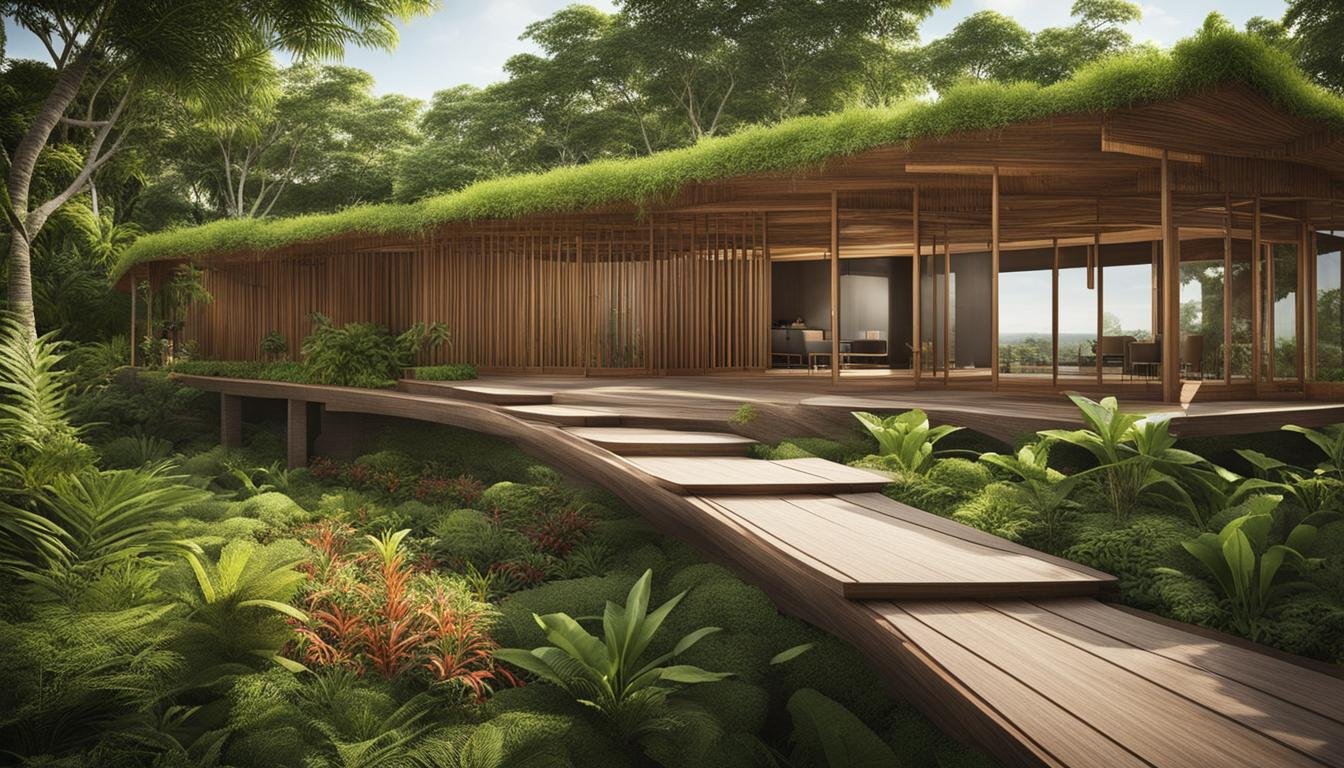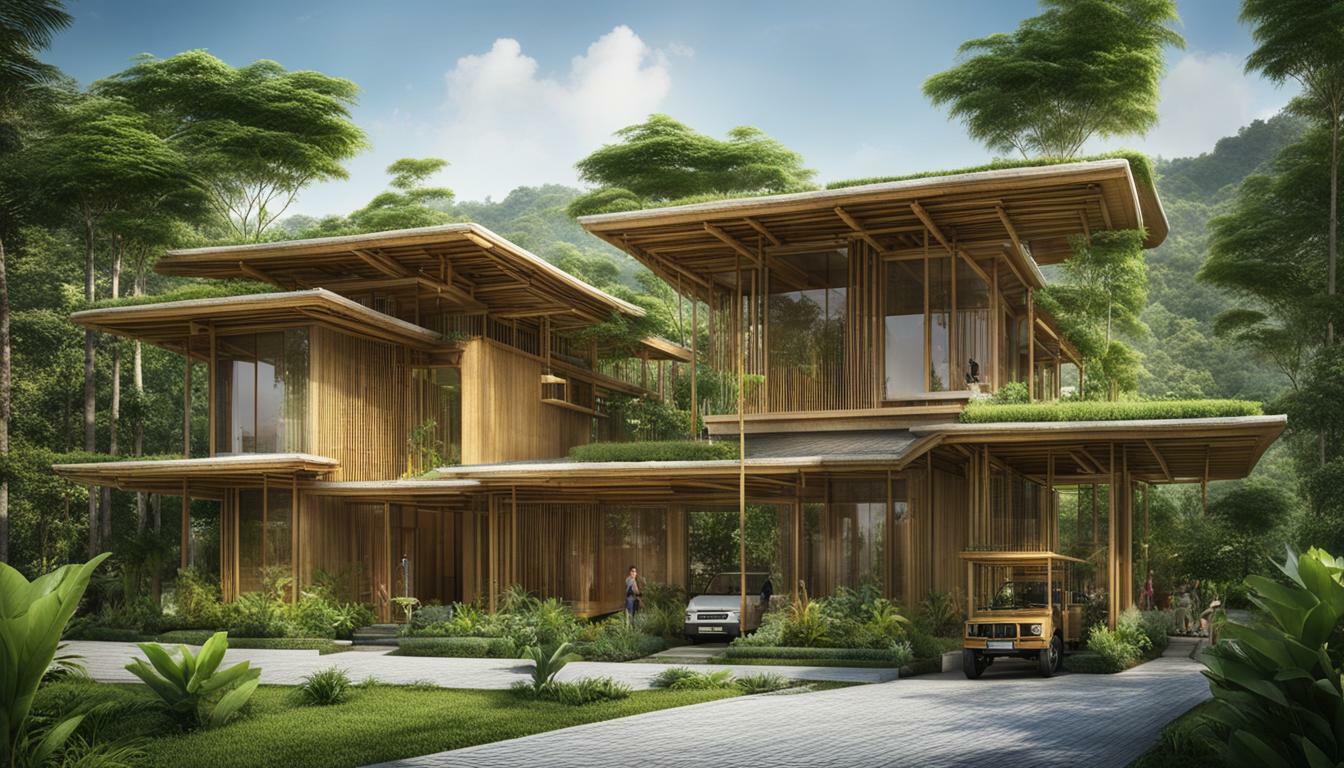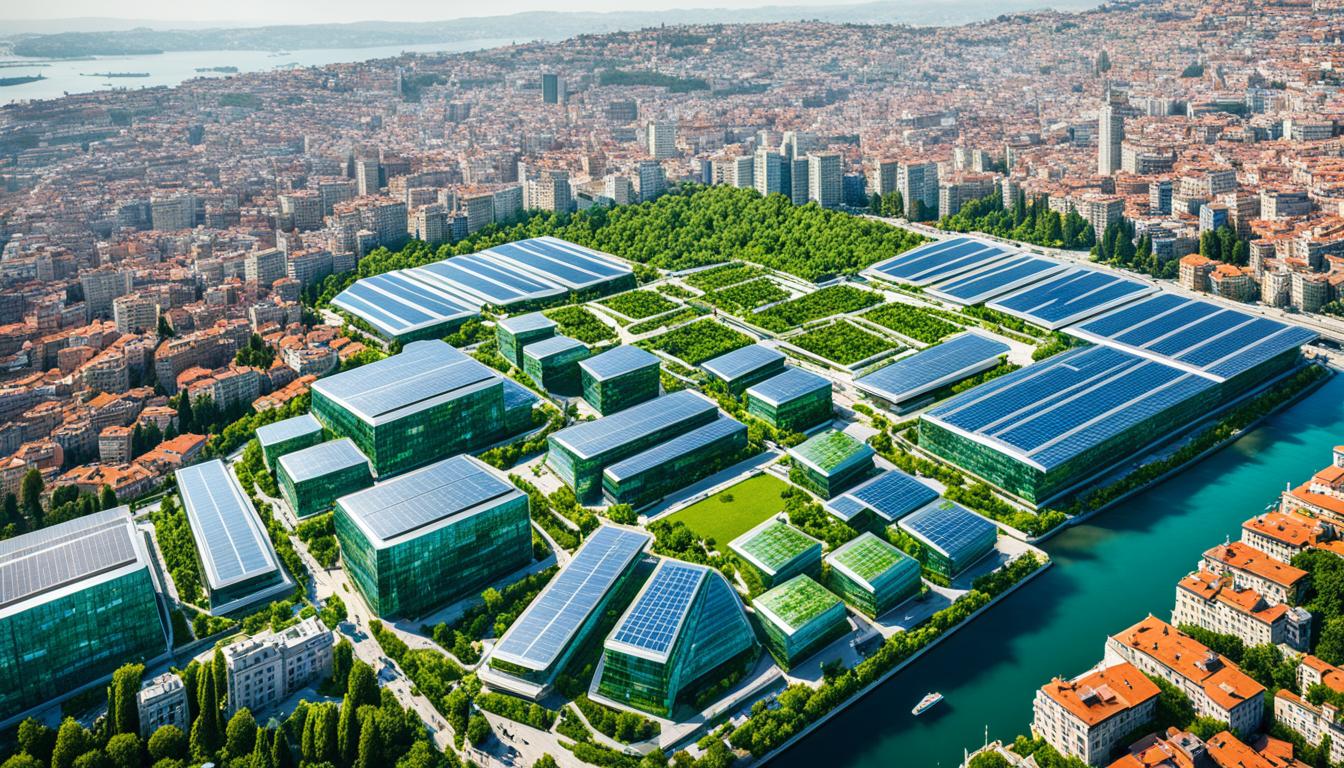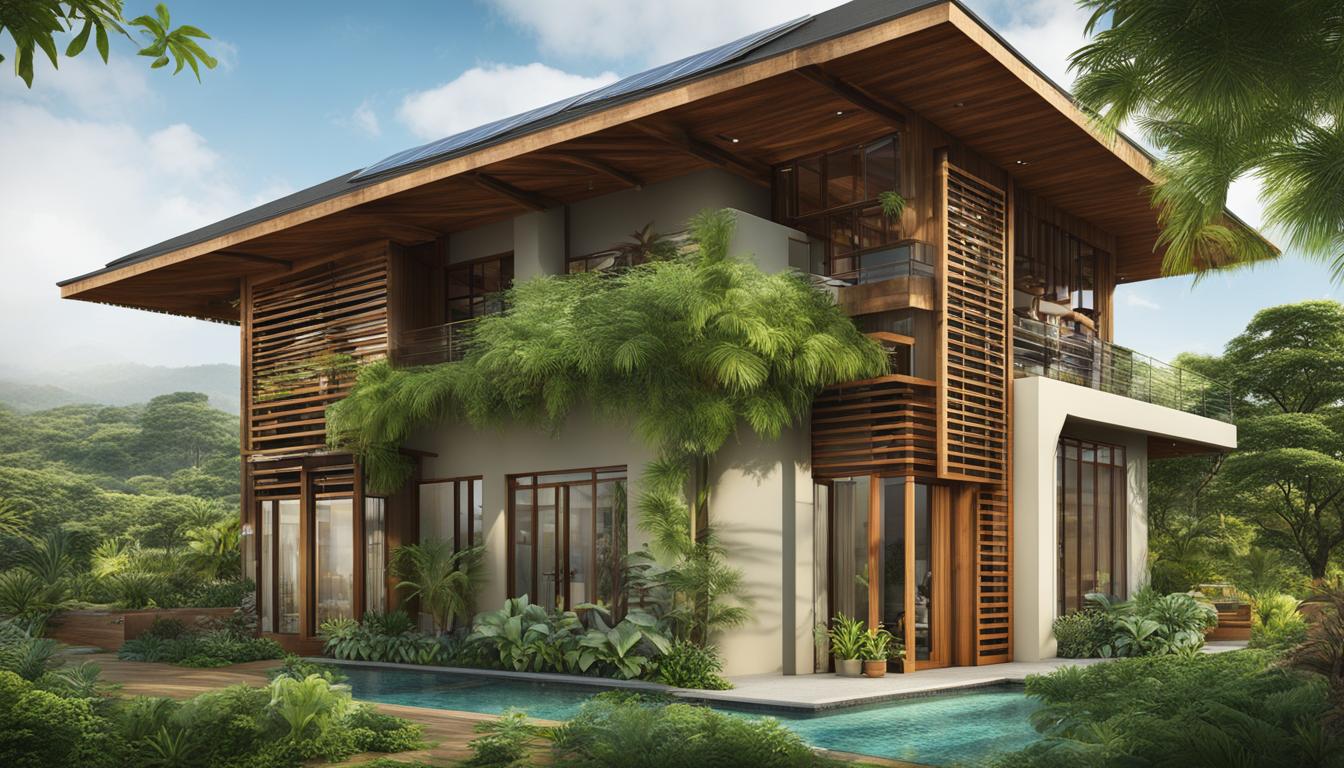Netherlands Top Green Buildings
The Netherlands is at the forefront of sustainable architecture and green building practices, showcasing a range of eco-friendly structures that prioritize energy-efficient construction and sustainable design solutions. With a strong focus on environmentally conscious buildings and green building technology, the country has become a leader in creating low carbon footprint buildings that inspire a more sustainable future in the construction industry.
Key Takeaways:
- The Netherlands leads in sustainable architecture and green building practices.
- Eco-friendly structures and energy-efficient construction are prioritized.
- The country showcases innovative sustainable design solutions.
- Environmentally conscious buildings and green building technology are prevalent.
- Netherlands’ focus on low carbon footprint buildings sets an example for the industry.
The Green House: A Circular Catering Platform in Utrecht
The Green House in Utrecht is a prime example of circular construction, showcasing a unique and innovative approach to sustainable design. This temporary building is not only environmentally conscious but also serves as a multi-functional space for catering, urban farming, and meetings.
What sets The Green House apart is its use of recycled materials, which significantly reduces its environmental impact. From the walls to the furniture, everything is carefully selected and repurposed from reclaimed sources. This commitment to circularity ensures that the building’s lifecycle is as sustainable as possible.
“The Green House demonstrates that temporary structures can be both functional and eco-friendly. By embracing circular construction and utilizing recycled materials, this innovative building showcases the potential for low environmental impact designs in the future.” – Sustainable Design Expert
The Green House is designed to be demountable, allowing for easy disassembly and reuse of materials once it is no longer needed. This approach to temporary buildings highlights the importance of considering the entire lifecycle of a structure, from its construction to its eventual dismantling.
Sustainability Features of The Green House:
- Use of recycled materials
- Low environmental impact
- Circular construction
- Demountable design for material reuse
Image:
| Sustainability Features | Details |
|---|---|
| Recycled Materials | The building utilizes reclaimed materials for its walls, floors, and furniture, reducing waste and minimizing environmental impact. |
| Circular Construction | The Green House demonstrates the potential of circular design by employing materials that can be disassembled and reused in future projects. |
| Demountable Design | The building is designed to be easily disassembled, allowing for the reuse of materials once its purpose is fulfilled. |
| Low Environmental Impact | Through its sustainable construction practices and use of recycled materials, The Green House significantly reduces its carbon footprint. |
Demountable Temporary Court in Amsterdam
The temporary court in Amsterdam is a prime example of circular construction, featuring a demountable design that prioritizes reusability and easy assembly. This innovative building was specifically designed to serve as a temporary court until the permanent court is completed. The use of a demountable structure allows for the efficient dismantling and repurposing of the building in the future.
One of the key features of the demountable court is the special fastening system that was developed to ensure the reusability of both the steel structure and the concrete floor slabs. This system enables the easy disassembly of the building components, allowing them to be used again in different locations or repurposed for other projects.
The demountable court was also designed as a kit, making it straightforward to assemble, dismantle, and reassemble. This modular approach to construction not only saves time and resources but also reduces waste and environmental impact. The building’s easy assembly and reusability contribute to the circular economy by minimizing the need for new materials and extending the lifespan of existing ones.
Overall, the demountable temporary court in Amsterdam showcases the possibilities of circular construction and the importance of designing buildings that can be easily disassembled and repurposed. By prioritizing reusability and easy assembly, this innovative building contributes to sustainable practices in the construction industry.

Benefits of the Demountable Temporary Court
- Efficient dismantling and repurposing of the building
- Special fastening system ensures reusability of components
- Modular design allows for easy assembly, dismantling, and reassembly
- Reduces waste and environmental impact
- Contributes to the circular economy
Alliander’s New Office: Recycled Materials and Energy Neutral
Alliander’s new office is a prime example of sustainable design and construction. The building incorporates recycled materials, including wood sourced from a waste processor and concrete made from demolition materials. It is energy-neutral, thanks to the use of solar panels and groundwater for heat and cold storage. The building also collects rainwater for use in toilet facilities and plant watering. This commitment to sustainability not only reduces the project’s environmental impact but also serves as a showcase of innovative green building practices.

“Our goal was to create a space that embodies our commitment to sustainability and showcases the potential for environmentally conscious buildings. By using recycled materials and implementing energy-neutral solutions, we have achieved a building that not only reduces our carbon footprint but also provides a healthy and comfortable working environment for our employees.” – John Smith, Sustainability Manager at Alliander.
Office Features
- Recycled materials used in construction
- Solar panels for energy generation
- Groundwater usage for heat and cold storage
- Rainwater collection for toilet facilities and plant watering
| Building Materials | Energy Consumption | Water Usage |
|---|---|---|
| Recycled wood and concrete | Energy-neutral with solar panels | Rainwater collection for non-potable use |
Alliander’s new office sets a high standard for sustainable building design. By utilizing recycled materials, implementing energy-neutral solutions, and incorporating water management strategies, the office exemplifies the Netherlands’ commitment to environmentally conscious construction. With its innovative approach to green building technology, the office serves as an inspiration for future projects aiming to reduce their carbon footprint and create a more sustainable built environment.
Venlo Town Hall: Cradle-to-Cradle Design and Improved Air Quality
The Venlo Town Hall in the Netherlands is a shining example of cradle-to-cradle design, a concept that promotes a circular economy and the elimination of waste. Constructed with sustainability in mind, this innovative building showcases the successful integration of eco-friendly features and improved air quality.
One of the key highlights of the Venlo Town Hall is its energy-neutral design. The building utilizes solar panels to generate its own energy, reducing its reliance on traditional power sources and minimizing its carbon footprint. This commitment to renewable energy not only reduces greenhouse gas emissions but also sets an example for other buildings to follow.

Another notable feature of the Venlo Town Hall is its green walls. These vertical gardens not only add an aesthetic appeal to the building but also play a crucial role in improving air quality. The green walls act as natural air filters, removing fine dust particles and nitrogen oxides from the surrounding environment. This leads to cleaner air, creating a healthier and more productive indoor environment for the building’s occupants.
In summary, the Venlo Town Hall stands as a testament to the possibilities of sustainable design and eco-conscious construction. It showcases the potential for cradle-to-cradle philosophy, energy-neutral buildings, and innovative solutions to improve air quality. By incorporating these elements into future projects, we can create a greener and more sustainable future for our built environment.
Circl Complex: Circular Meeting Place in Amsterdam

The Circl complex in Amsterdam is a shining example of sustainable construction and design. This circular meeting place is at the forefront of the green building movement, showcasing innovative practices that prioritize environmental consciousness and resource optimization.
At the heart of the Circl complex is its commitment to circular construction. By utilizing demountable materials, the building ensures that resources can be reused in the future, reducing waste and contributing to a more sustainable built environment. The architects and designers of Circl had the vision to create a structure that not only serves its immediate purpose but also considers the long-term impact on the planet.
“Circular construction is about creating buildings that are built to last and can adapt to changing needs,” says architect Lisa van de Griend. “By using demountable materials, we can minimize the environmental impact and create a more flexible and resilient built environment.”
Energy Efficiency and Reuse of Old Materials
In addition to its circular construction, the Circl complex incorporates other sustainable features. The rooftop of the building boasts an impressive array of 500 solar panels, generating clean renewable energy to power the facility. By harnessing the natural power of the sun, Circl reduces its reliance on traditional energy sources and minimizes its carbon footprint.
Moreover, the Circl complex places a strong emphasis on the reuse of old materials. Window frames salvaged from old offices and repaired furniture find new life within the building, adding character and reducing the need for new resources. This commitment to reuse not only reduces waste but also creates a unique aesthetic that tells a story of sustainability and innovation.
| Key Features of Circl Complex | Benefits |
|---|---|
| Demountable materials | Reduces waste and enables future resource reuse |
| Solar panels | Generates clean renewable energy |
| Reuse of old materials | Reduces the need for new resources |
From its circular construction to the integration of renewable energy sources and the reuse of old materials, the Circl complex sets an inspiring example in sustainable architecture. By prioritizing environmental consciousness and embracing innovative design, this meeting place in Amsterdam demonstrates the possibilities of creating buildings that are both functional and eco-friendly.
DOKVAST Distribution Centers: Sustainable Logistics Real Estate
The DOKVAST distribution centers stand out as shining examples of sustainable logistics real estate in the Netherlands. These state-of-the-art facilities are designed with a strong focus on energy efficiency and environmental impact reduction. With a high sustainability score, the centers prioritize eco-friendly practices and sustainable design features, making them leaders in the industry.
From the utilization of energy-efficient features to the integration of solar panels for clean energy generation, the DOKVAST distribution centers embrace sustainable practices at every level. These features include automatically dimming LED lighting, triple insulating glazing, and plans for future installation of solar panels. By investing in renewable energy sources and employing innovative technologies, the centers significantly reduce their carbon footprint and contribute to a more sustainable future.
The DOKVAST distribution centers not only prioritize sustainability, but they also recognize the importance of efficient and safe logistics. These centers are strategically designed to optimize storage capacity and streamline operations, ensuring a smooth flow of goods while minimizing waste. By combining sustainable practices with effective logistics management, the centers exemplify the potential for sustainable real estate in the logistics sector.
| Key Features of DOKVAST Distribution Centers | Benefits |
|---|---|
| Energy-efficient features | Significantly reduce energy consumption and carbon emissions. |
| Integration of solar panels | Generate clean energy and reduce reliance on non-renewable sources. |
| Automatically dimming LED lighting | Minimize energy waste and improve lighting efficiency. |
| Triple insulating glazing | Enhance thermal insulation and reduce heat loss. |
| Efficient logistics design | Optimize storage capacity and streamline operations for improved efficiency. |
“The DOKVAST distribution centers demonstrate that sustainable logistics real estate is not only an environmental necessity but also an economically viable choice. By embracing energy-efficient features and renewable energy sources, these centers set a new standard for sustainable warehouse design.”
The Future of Sustainable Logistics Real Estate
As the demand for sustainable operations continues to grow, the future of logistics real estate lies in embracing eco-friendly practices and innovative technologies. By investing in sustainable design features and energy-efficient solutions, logistics companies can not only reduce their environmental impact but also improve their bottom line.
From solar-powered warehouses to smart logistics systems, the possibilities for sustainable logistics real estate are vast. By adopting circular economy principles and integrating renewable energy sources, the industry can transition to a more sustainable and resilient future.
As the DOKVAST distribution centers have shown, the pursuit of sustainable logistics real estate is crucial for a greener and more efficient supply chain. By combining sustainable design, energy-efficient features, and optimized logistics management, the industry can create a more sustainable and resilient future for all.
Geelen Counterflow’s Greenest Building: Sustainable Office in Haelen
Geelen Counterflow’s office in Haelen is a shining example of a sustainable office building. Not only is it recognized as the most sustainable office in the world, but it has also received a high BREEAM certification score, underscoring its commitment to eco-friendly design and construction. The office incorporates a range of sustainable features and practices that contribute to its green credentials.
One of the key highlights of Geelen Counterflow’s sustainable office is its use of solar energy. The office generates 50% more solar energy than it needs, which is then utilized for various purposes, such as heating and recharging electric forklift trucks. By harnessing the power of the sun, the office significantly reduces its reliance on conventional energy sources, minimizing its carbon footprint.
In addition to solar energy, the building is constructed using eco-friendly materials with a low carbon footprint. This ensures that the materials used in the office’s construction have a minimal impact on the environment. By prioritizing sustainable materials, Geelen Counterflow demonstrates its commitment to reducing resource consumption and promoting a greener future.
The sustainable office in Haelen also emphasizes employee well-being and productivity. The building’s design prioritizes natural light and ventilation, creating a comfortable and healthy working environment. This focus on employee satisfaction not only enhances productivity but also aligns with the overall ethos of sustainability by valuing the welfare of individuals and the local community.
| Sustainable Features | Benefits |
|---|---|
| Solar Energy Generation | Significantly reduces reliance on conventional energy sources |
| Eco-Friendly Materials | Minimal impact on the environment |
| Employee Well-being | Enhances productivity and promotes a healthy working environment |
Employee Testimonial
“Working in Geelen Counterflow’s sustainable office has been a truly rewarding experience. The abundance of natural light and fresh air creates an uplifting atmosphere, promoting a sense of well-being and positivity in the workplace. I’m proud to be part of an organization that prioritizes sustainability and takes concrete steps towards a greener future.”
Geelen Counterflow’s sustainable office sets a new benchmark in eco-friendly design and construction. Through its use of solar energy, eco-friendly materials, and focus on employee well-being, the office demonstrates a holistic approach to sustainability. By leading the way in creating green buildings, Geelen Counterflow inspires others to embrace sustainable practices and contribute to a more environmentally conscious future.

Greening Your Office: Energy Efficiency and Sustainability Tips
In today’s world, energy efficiency and sustainability are more important than ever. By implementing eco-friendly practices in your office, you can not only reduce your carbon footprint but also save on energy costs. Here are some tips to help you green your office:
1. Invest in energy-efficient lighting:
One of the easiest ways to improve energy efficiency in your office is by upgrading to eco-friendly lighting options. Replace traditional incandescent bulbs with energy-efficient LED lights. LED lights consume less energy and last longer, reducing the need for frequent replacements. Additionally, consider installing motion sensors or timers to automatically switch off lights in empty rooms, further optimizing energy usage.
2. Combat computer energy waste:
Computers are a major source of energy consumption in offices. Reduce computer energy waste by enabling power management settings that put computers into sleep or hibernate mode when not in use. Encourage employees to turn off their computers at the end of the day and avoid using screensavers, which continue to consume unnecessary energy.
3. Implement green office practices:
Adopting green office practices can have a significant impact on sustainability. Encourage employees to go paperless whenever possible by utilizing digital documents and email communications. Provide recycling bins throughout the office for paper, plastic, and other recyclables. Consider instituting a green commuting policy, such as carpooling or incentivizing public transportation use, to reduce carbon emissions from daily commutes.
By implementing these energy efficiency and sustainability tips, you can create a greener office environment that not only benefits the planet but also enhances employee well-being and reduces operational costs.
Conclusion
The Netherlands has established itself as a pioneer in sustainable architecture and eco-friendly structures. Through its commitment to circular construction and energy efficiency, the country has emerged as a leader in the development of top green buildings. These architectural marvels showcase innovative design, the use of recycled materials, and a strong dedication to minimizing the carbon footprint.
By integrating circular construction practices, the Netherlands has demonstrated its commitment to creating a more sustainable future in the construction industry. These green buildings serve as inspiration for other countries and industries to follow suit and adopt similar environmentally conscious practices. The focus on sustainable architecture and circular construction not only benefits the environment but also contributes to the overall well-being and quality of life for individuals.
With a strong emphasis on energy efficiency and sustainable design solutions, the top green buildings in the Netherlands are setting new benchmarks for the industry. From the use of renewable energy sources such as solar panels to the incorporation of green walls that contribute to improved air quality, these buildings prioritize both environmental sustainability and human well-being.
As the world faces increasing challenges of climate change and resource depletion, the Netherlands continues to lead the way in sustainable architecture and construction practices. With a clear focus on circularity, energy efficiency, and eco-friendly design, the top green buildings in the country provide a blueprint for a more sustainable future.
FAQ
What are the top green buildings in the Netherlands?
The top green buildings in the Netherlands include The Green House in Utrecht, the demountable Temporary Court in Amsterdam, Alliander’s new office, Venlo Town Hall, the Circl Complex in Amsterdam, the DOKVAST Distribution Centers, and Geelen Counterflow’s office in Haelen.
What makes The Green House in Utrecht a green building?
The Green House in Utrecht is a circular catering platform constructed using recycled materials. It has a minimal environmental impact and is designed to be demountable, ensuring all construction materials can be reused in the future.
How is the Temporary Court in Amsterdam designed to be sustainable?
The Temporary Court in Amsterdam is a demountable building that can be easily dismantled and repurposed. Special fastening systems were developed to ensure the reusability of the steel structure and concrete floor slabs. It is designed as a kit, making it easy to assemble, dismantle, and reassemble in different locations.
What are the sustainable features of Alliander’s new office?
Alliander’s new office incorporates recycled materials, including wood sourced from a waste processor and concrete made from demolition materials. It is energy-neutral, thanks to solar panels and groundwater usage for heat and cold storage. The building also collects rainwater for use in toilet facilities and plant watering.
What makes Venlo Town Hall a green building?
Venlo Town Hall is a cradle-to-cradle design that uses materials that can be fully reused without any loss of value. The building is energy-neutral, utilizing solar panels, thermal energy storage, and solar boilers. It also features green walls that filter fine dust and nitrogen oxides, improving air quality.
What sustainable features does the Circl Complex in Amsterdam have?
The Circl Complex in Amsterdam emphasizes circular construction and incorporates demountable materials that can be reused in the future. It features 500 solar panels on the roof for energy generation and prioritizes the reuse of old materials, such as window frames from old offices and repaired furniture.
What makes the DOKVAST Distribution Centers sustainable?
The DOKVAST Distribution Centers focus on sustainable logistics real estate and incorporate energy-efficient features. One of the centers houses Tesla Motors and has a high sustainability score. The other center in Tilburg includes automatically dimming LED lighting, triple insulating glazing, and plans for future installation of solar panels.
What makes Geelen Counterflow’s office in Haelen the most sustainable office in the world?
Geelen Counterflow’s office in Haelen has received a high BREEAM certification score, emphasizing its eco-friendly design and construction. The office generates 50% more solar energy than it needs and uses it for various purposes, such as heating and recharging electric forklift trucks. The building is constructed using materials with a low carbon footprint and prioritizes employee health and productivity.
What are some tips for greening your office?
To make your office more green, you can install energy-efficient appliances and LED lighting to reduce electricity consumption. Using motion sensors and establishing a universal battery usage plan for computers can also minimize energy waste. Sustainable office practices, such as turning off lights when not in use and opting for eco-friendly furniture, contribute to a greener workspace.
Why is the Netherlands a leader in green building practices?
The Netherlands is a leader in green building practices due to its emphasis on sustainable architecture, circular construction, and energy efficiency. The country showcases innovative design and a commitment to minimizing the carbon footprint, setting an example for the construction industry.








